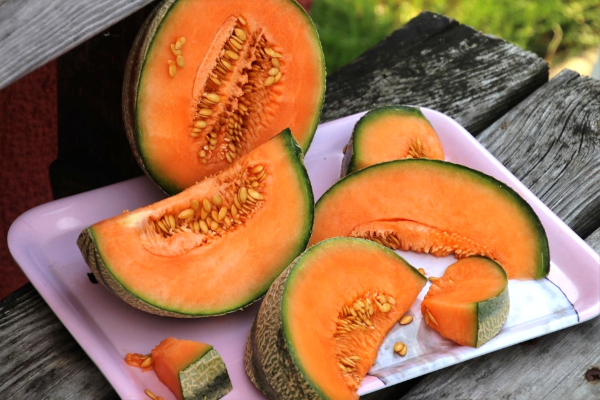 Plant Biology
Plant Biology
Another sweet story
During domestication humans select and maintain plants that have higher yield and better quality. Until recently, we were unaware of the genetic causes underlying this selection. However, with the advances in genomics, we can now identify the genetic changes that occurred during the domestication of crops.

Humans started growing melons as crops around four thousand years ago. Since then, melons became one of the most abundantly cultivated fruits and today rank among the top 10 crops in terms of economic importance. Cultivated melons, like many other agricultural plants, originated from wild fruit and underwent striking changes improving their taste and quality. The authors of the study published in Nature Genetics revealed the genetic causes that underlie the changes in shape, color, taste and size of melons and therefore enhance their agricultural and economic value.
Recent studies have suggested that the first ancestors of melon and its siblings (such as pumpkin and cucumber) emerged in Africa and spread all over the world through India and Australia. Since the first cultivation, people selected and maintained melons with beneficial traits enhancing the fruit's quality and yield. This process, called domestication, laid the foundations of today's civilization as it allowed people to rely less on hunting and to invest more of their time in tool production and formation of more complex societal and political structures.
As for any other living organism, a melon's traits are encoded in its genome, the collection of all its genes. To find out which genes changed during domestication, the authors compared the genomes of 1175 samples of two closely related melon types called melo and agrestis. Depending on the differences in their genomes, these melons fell into one of the three categories: primitive African type and two types of India-originated melons. Because the number of melons of the African type was small, the authors excluded them from further analysis.
Next, they carefully studied and compared the genomes of wild and cultivated melons to determine the genetic differences. The genetic differences between wild melo and wild agrestis were much more striking than those between cultivated melo and cultivated agrestis across all categories. This implies that by promoting particular traits, domestication reduced the genetic differences between the various melon types.
To identify genes responsible for different traits, the researchers crossed wild and domesticated siblings of corresponding melon types and analyzed the resulting offspring. Crossing produces multiple lines of offspring, which carry different traits and different genetic information and therefore allows to trace the trait-gene relationships. Overall, the authors have connected 208 genetic differences to 16 traits such as fruit color, taste, mass and shape. Despite the similarities between the two types, the researchers also discovered that the domestication of melo and agrestis seemed to have occurred independently in terms of flesh bitterness, acidity and fruit mass.
The findings of the study not only enlighten the history of melon domestication, but also enable to breed melons in a much more efficient way in the future. The genetic variations identified in the study can be used in different combinations to cultivate novel types of melon. However, a challenge for such studies is to identify complex interactions between genes and traits. In some cases, one gene can have several functions, so its alterations may affect multiple traits. Inversely, many genes can underlie a single trait. Untangling of such relationships will require meticulous attention.
Furthermore, as the authors possessed too few African type samples, the picture lacks a significant part of the history of melon domestication. It could be therefore interesting to include them in the future experiments and shed light upon the initial spreading of melons from Africa.
In conclusion, this study provides a concrete evidence of how domestication of melon by ancient humans affected its genome. Similar approaches have been applied to many other crops such as rice, cotton, cucumber, and tomato. With melon now also added to the list, more agricultural species will surely follow in the near future.
Original Article:
Zhao G, Lian Q, Zhang Z et al. A comprehensive genome variation map of melon identifies multiple domestication events and loci influencing agronomic traits. Nature Genetics 51(11):1607-1615 (2019).
Next read: Making “hoppy” beer without hops by Akira Ohkubo
Edited by:
Dr. Beata Kusmider , Managing Editor
We thought you might like
Attractive in the dark — how petunias may help to feed humanity
Apr 27, 2016 in Plant Biology | 3 min read by Graham RobinsonA special delivery for malaria-transmitting mosquitoes
Dec 18, 2019 in Health & Physiology | 3.5 min read by Etienne Bilgo , Brian LovettHow robots can learn to grasp from humans
May 22, 2020 in Maths, Physics & Chemistry | 3.5 min read by Subramanian SundaramMore from Plant Biology
Unravelling the Secrets of Pine Roots: A Tale of Nutrition and Adaptation
Oct 20, 2023 in Plant Biology | 3.5 min read by Rafael Cañas , Francisco OrtigosaStressful memories help plants resist caterpillars
Oct 2, 2023 in Plant Biology | 3.5 min read by Samuel Wilkinson , Adam Hannan Parker , Jurriaan TonDecoding the genome of a jackfruit that grows all year round
Sep 6, 2023 in Plant Biology | 3.5 min read by Tofazzal IslamLife after logging: the tale of recovering tropical forests
Aug 21, 2023 in Plant Biology | 3.5 min read by Maria Mills , Terhi RiuttaEditor's picks
Trending now
Popular topics


